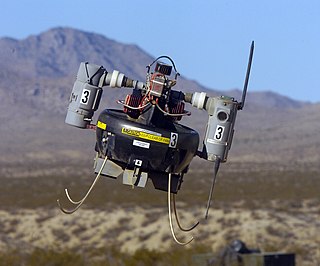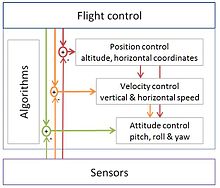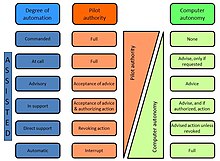An autonomous robot is a robot that acts without recourse to human control. Historic examples include space probes. Modern examples include self-driving vacuums and cars.

An unmanned aerial vehicle (UAV), commonly known as a drone, is an aircraft without any human pilot, crew, or passengers on board. UAVs were originally developed through the twentieth century for military missions too "dull, dirty or dangerous" for humans, and by the twenty-first, they had become essential assets to most militaries. As control technologies improved and costs fell, their use expanded to many non-military applications. These include aerial photography, area coverage, precision agriculture, forest fire monitoring, river monitoring, environmental monitoring, policing and surveillance, infrastructure inspections, smuggling, product deliveries, entertainment, and drone racing.

A micro air vehicle (MAV), or micro aerial vehicle, is a class of man-portable miniature UAVs whose size enables them to be used in low-altitude, close-in support operations. Modern MAVs can be as small as 5 centimeters - compare Nano Air Vehicle. Development is driven by commercial, research, government, and military organizations; with insect-sized aircraft reportedly expected in the future. The small craft allow remote observation of hazardous environments or of areas inaccessible to ground vehicles. Hobbyists have designed MAVs for applications such as aerial robotics contests and aerial photography. MAVs can offer autonomous modes of flight.

Swarm robotics is an approach to the coordination of multiple robots as a system which consist of large numbers of mostly simple physical robots. ″In a robot swarm, the collective behavior of the robots results from local interactions between the robots and between the robots and the environment in which they act.″ It is supposed that a desired collective behavior emerges from the interactions between the robots and interactions of robots with the environment. This approach emerged on the field of artificial swarm intelligence, as well as the biological studies of insects, ants and other fields in nature, where swarm behaviour occurs.

Aerial survey is a method of collecting geomatics or other imagery by using airplanes, helicopters, UAVs, balloons or other aerial methods. Typical types of data collected include aerial photography, Lidar, remote sensing and also geophysical data (such as aeromagnetic surveys and gravity. It can also refer to the chart or map made by analysing a region from the air. Aerial survey should be distinguished from satellite imagery technologies because of its better resolution, quality and atmospheric conditions. Today, aerial survey is sometimes recognized as a synonym for aerophotogrammetry, part of photogrammetry where the camera is placed in the air. Measurements on aerial images are provided by photogrammetric technologies and methods.

AeroVironment, Inc. is an American defense contractor headquartered in Arlington, Virginia, that designs and manufactures unmanned aerial vehicles (UAVs). Paul B. MacCready Jr., a designer of human-powered aircraft, founded the company in 1971. The company is best known for its lightweight human-powered and solar-powered vehicles. The company is the US military's top supplier of small drones —notably the Raven, Switchblade, Wasp and Puma models.

The Lockheed DC-130 is a variant of the C-130 Hercules modified for drone control. It can carry four Ryan Firebee drones underneath its wings.
The usefulness of UAVs for aerial reconnaissance was demonstrated to the United States in the Vietnam War. At the same time, early steps were being taken to use them in active combat at sea and on land, but unmanned combat aerial vehicles would not come into their own until the 1980s.

The Boeing A160 Hummingbird is an unmanned aerial vehicle (UAV) helicopter. Its design incorporates many new technologies never before used in helicopters, allowing for greater endurance and altitude than any helicopter currently in operation.

First-person view (FPV), also known as remote-person view (RPV), or video piloting, is a method used to control a radio-controlled vehicle from the driver or pilot's viewpoint. Most commonly it is used to pilot a radio-controlled aircraft or other type of unmanned aerial vehicle (UAV) such as a military drone. The operator gets a first-person perspective from an onboard camera that feeds video to FPV goggles or a monitor. More sophisticated setups include a pan-and-tilt gimbaled camera controlled by a gyroscope sensor in the pilot's goggles and with dual onboard cameras, enabling a true stereoscopic view.
The Australian Research Centre for Aerospace Automation (ARCAA) was a research centre of the Queensland University of Technology. ARCAA conducted research into all aspects of aviation automation, with a particular research focus on autonomous technologies which support the more efficient and safer utilisation of airspace, and the development of autonomous aircraft and on-board sensor systems for a wide range of commercial applications.

An uncrewed vehicle or unmanned vehicle is a vehicle without a person on board. Uncrewed vehicles can either be under telerobotic control—remote controlled or remote guided vehicles—or they can be autonomously controlled—autonomous vehicles—which are capable of sensing their environment and navigating on their own.

Ghatak is an autonomous jet powered stealthy unmanned combat air vehicle (UCAV), being developed by Aeronautical Development Establishment (ADE) of the Defence Research and Development Organisation (DRDO) for the Indian Air Force. The design work on the UCAV is to be carried out by Aeronautical Development Agency (ADA). Autonomous Unmanned Research Aircraft (AURA) was a tentative name for the UCAV. Details of the project are classified.
Paparazzi is an open-source autopilot system oriented toward inexpensive autonomous aircraft. Low cost and availability enable hobbyist use in small remotely piloted aircraft. The project began in 2003, and is being further developed and used at École nationale de l'aviation civile (ENAC), a French civil aeronautics academy. Several vendors are currently producing Paparazzi autopilots and accessories.
ArduPilot is an open source, uncrewed vehicle Autopilot Software Suite, capable of controlling:
Unmanned aircraft system simulation focuses on training pilots to control an unmanned aircraft or its payload from a control station. Flight simulation involves a device that artificially re-creates aircraft flight and the environment in which it flies for pilot training, design, or other purposes. It includes replicating the equations that govern how aircraft fly, how they react to applications of flight controls, the effects of other aircraft systems, and how the aircraft reacts to external factors such as air density, turbulence, wind shear, cloud, precipitation, etc.

INDELA-I.N.SKY is a Belarusian rotary wing unmanned aerial vehicle, medium-range with the weight up to 140 kg. It is developed and produced by KB INDELA Ltd. Serial production has been set up since 2014.
Primoco UAV is a Czech company that creates unmanned aerial vehicles designed for both civilian and military applications. Its first model took flight in July 2015 and the UAV Model One 100 started full production in January 2016.

The Raytheon Coyote is a small, expendable, unmanned aircraft system built by the Raytheon Company, with the capability of operating in autonomous swarms. It is launched from a sonobuoy canister with the wings deploying in early flight phase.

The HAL Combat Air Teaming System (CATS) is an Indian unmanned and manned combat aircraft air teaming system being developed by Hindustan Aeronautics Limited (HAL). The system will consist of a manned fighter aircraft acting as "mothership" of the system and a set of swarming UAVs and UCAVs governed by the mothership aircraft. A twin-seated HAL Tejas is likely to be the mothership aircraft. Various other sub components of the system are currently under development and will be jointly produced by HAL, National Aerospace Laboratories (NAL), Defence Research and Development Organisation (DRDO) and Newspace Research & Technologies.


















